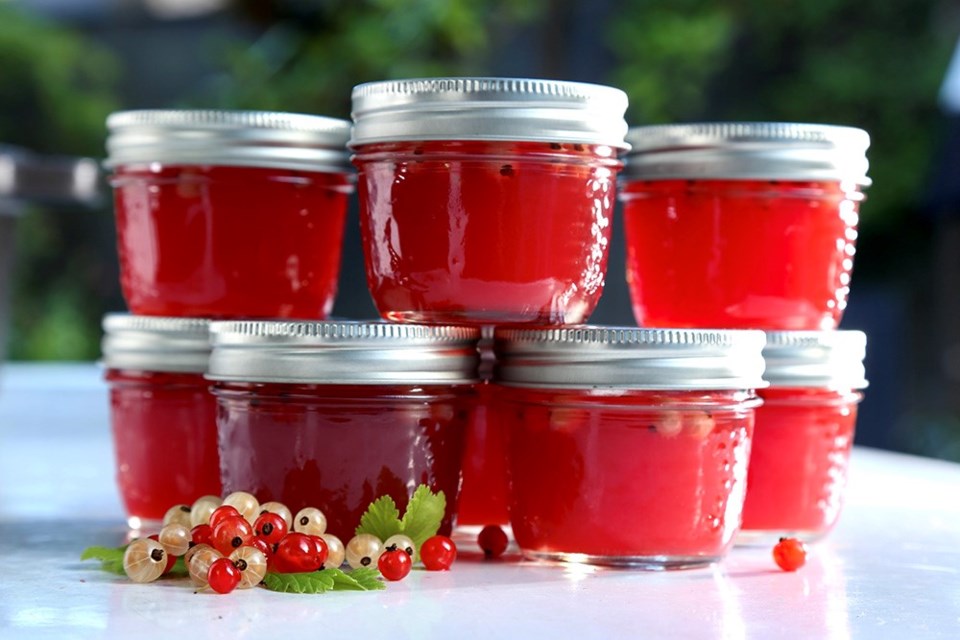Veggie dog Dave and I dodged lethal Ribes thorns this week in the berry patch, determined to harvest the black, red and green gooseberries, red and white currants, and jostaberries (black currant and gooseberry cross) before they ripened fully and caught the attention of black bear and other wildlife.
My urban permaculture sensibilities knew that bear-proofing was essential, but my chef brain fretted over low sugar content, and how best to sweeten three species of berries that aren’t all that sweet at the best of times.
Mulling things over as one does in the garden, I thought too about the people who most enjoy my preserves, but for whom sugar is particularly problematic.The truth is that consuming white sugar is a bad idea for most of us, and while honey and maple syrup make fine substitutes in many situations, one cannot simply swap sugar for honey when making preserves. For one thing, honey is 25 per cent more sweet than sugar, plus sugar adds requisite body and texture.
I did a bit of research and discovered that, by employing some basic math and natural science, I could reimagine all of my favourite preserve recipes as sugar-free formulas, without compromising flavour or using processed artificial sweeteners like Stevia or Aspartame.
By using 100 per cent citrus pectin (extracted from dried citrus peels) and soluble calcium (food grade mineral) in combination with a small amount of honey, one can achieve body, texture and sweetness, without using enormous amounts of sugar.
Unlike popular commercial pectins that rely on sugar for jelling power, low-methoxyl citrus pectin is activated by calcium, and then only in a low sugar environment. Many jams and preserve recipes, especially those passed down through generations, suggest using a 1:1 ratio of fruit to white sugar. Yikes!
There is an all-natural, Italian made product called Pomona’s Universal Pectin (available at grocers) that simplifies the transition to sugar-free canning. Pomona’s two small packets, one containing powdered modified citrus pectin and another containing powdered calcium, are all that one needs to get started. The included instructions can be a bit baffling, but the actual process is really very simple. First, determine whether the fruit being preserved is naturally high in pectin, or low. Next, use the suggested high/low ratios of pectin, soluble calcium, and honey or maple syrup (sorghum agave, etc) to modify jam or jelly type recipes.
Measure the fruit, calculate the very small amounts of pectin and soluble calcium suggested (dissolve the calcium powder in water before measuring), add the calcium water to the fruit, then stir in the honey (modest 25 per cent by volume) into which pectin has been incorporated. Process as usual. Easy as pie — or sugar-free pie filling.
I hot-water processed a dozen small jars of white and red currants jelly, spiced slightly with vanilla and essence of ginger and lemon, using honey as my sweetener. It turned out beautifully and was a breeze to make. Old linen dinner napkins repurposed my grandmother’s old applesauce sieve into a jelly bag. I left the set-up on the counter overnight to drip away, and awoke to the most glorious cotton candy pink juice.
The gooseberries and jostaberries looked rather fallish, so I made a berry and date chutney using odds and sods ingredients like red onion, dried roast shallots and garlic, citrus peel, dried barberries and long green raisins.The dried aromatics absorbed much of the berry juice during cooking, so body wasn’t a concern. To finish, some home-made Moroccan spice blend, and a touch of sea salt.
There was enough natural sweetness in the dates and raisins that I didn’t really need honey, but I added just a bit, together with some calcium water. The savoury chutney is gorgeous, reminiscent of Cumberland sauce, and will be more delicious after a few months under seal.
I processed about five kilos of fruit and used but one-half package of Pomona’s — a good thing as canning season has only just begun.
One caveat worth noting — yield volumes will decrease in direct proportion to the amount of toxic white sugar diverted from recipes. Pretty sweet! Visit Pomona’s website for inspiration.
Laura Marie Neubert is a West Vancouver-based urban permaculture designer. Follow her on Instagram @upfrontandbeautiful, learn more about permaculture by visiting her Upfront & Beautiful website or email your questions to her here.
For a taste of permaculture, click on the YouTube link below:
(Video - Courtesy of West Vancouver Memorial Library)



